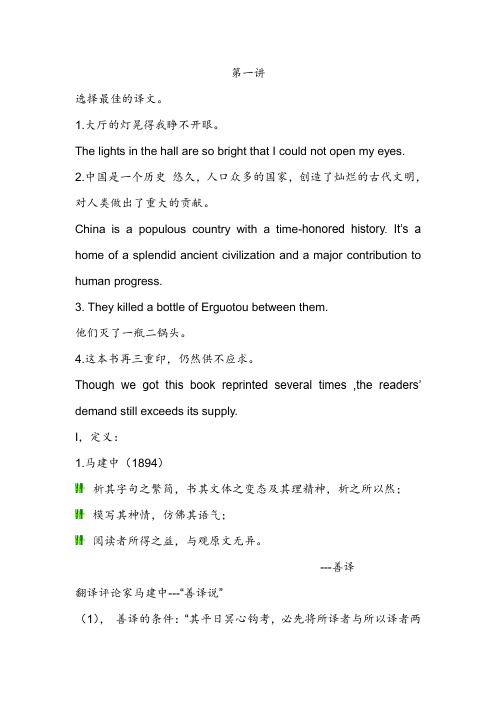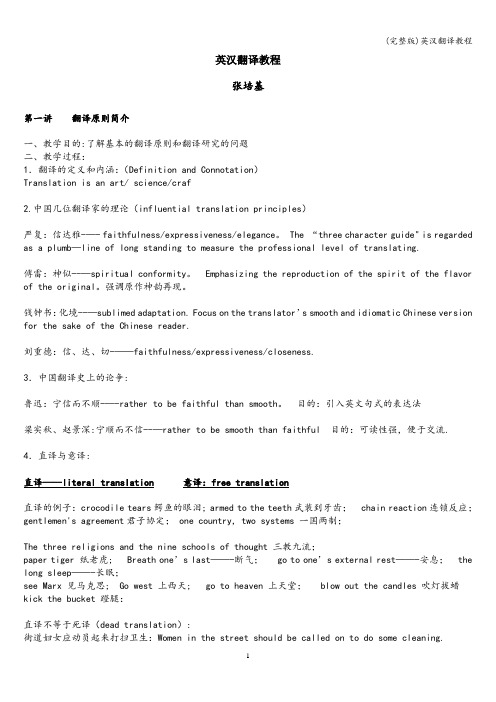翻译教程01
- 格式:ppt
- 大小:535.50 KB
- 文档页数:47


第一讲选择最佳的译文。
1.大厅的灯晃得我睁不开眼。
The lights in the hall are so bright that I could not open my eyes. 2.中国是一个历史悠久,人口众多的国家,创造了灿烂的古代文明,对人类做出了重大的贡献。
China is a populous country with a time-honored history. It’s a home of a splendid ancient civilization and a major contribution to human progress.3. They killed a bottle of Erguotou between them.他们灭了一瓶二锅头。
4.这本书再三重印,仍然供不应求。
Though we got this book reprinted several times ,the readers’ demand still exceeds its supply.I,定义:1.马建中(1894)析其字句之繁简,书其文体之变态及其理精神,析之所以然;模写其神情,仿佛其语气;阅读者所得之益,与观原文无异。
---善译翻译评论家马建中---“善译说”(1),善译的条件:“其平日冥心钩考,必先将所译者与所以译者两国文字深嗜笃好…”强调译者平日对本国语言文字和对象国语言文字必须有很高的修养,对语法学、词源学、文体学、修辞学等学科佑很深的研究,这是对译者的素养提出的最高要求。
(2),善译的过程:“一书到手,经营反复,确知其意旨之所在,而又摹写其神情,仿佛其语气,然后心悟神解,振笔而书”。
这体现了译者在整个翻译过程中理解和表达的全部。
(3),善译的实质:“译成之文适如其所译而止,而曾无毫发出入于其间”。
也就是“等值”翻译理论。
(4),善译的效果:“能使阅者所得之益与观原文无异”,这实质上达到了所谓“等效”翻译的效果。


![大学英语翻译全教程第一讲(完美版)[范文大全]](https://img.taocdn.com/s1/m/e5ef493015791711cc7931b765ce050877327575.png)
大学英语翻译全教程第一讲(完美版)[范文大全]第一篇:大学英语翻译全教程第一讲(完美版)翻译理论与实践(以《英语翻译教程》南开大学出版社为基础)第一讲翻译概述一、翻译的概念1.广义的翻译指语言与语言、语言与非语言等代码转换和基本信息的传达。
它包括不同语言间的翻译(如英汉互译)语言变体间的翻译(如古今语言、不同方言的互译)、语言与其他交际符号的转换(如把交通规则画成交通标志)。
他对翻译的内容只强调“基本信息”,不强调“完全的忠实”。
也有翻译家提出“理解也是翻译”的理论,这就把语言与思维也包括在广义的翻译里了。
2.狭义的翻译指语言活动,是把一种语言所表达的内容中式地用另一种远表达出来。
这个定义强调“是一种语言活动”,表明它是人类多种交际方式中语言交际的沟通;强调“一种语言到另一种语言”,排除了同一语言间各变体的互译;强调“忠实地”,避免了翻译与释义或改写的混淆。
奈达(Eugene Nida)“Translation consists in reproducing in the receptor language the closest natural equivalent of the source-language message, first in terms of meaning and second in terms of style.”(Nida & Taber: Th e Theory and Practice of Translation)我们的翻译课讲的就是狭义的翻译,并专指“书面表达内容”,以区别于有独特之处的口译(interpretation)。
二、翻译的分类1.从所涉及的代码性质看,可分为语内翻译(intralingual translation)、语际翻译(interlingual translation)和语符翻译(intersemiotic translation)。

英汉翻译教程张培基第一讲翻译原则简介一、教学目的:了解基本的翻译原则和翻译研究的问题二、教学过程:1.翻译的定义和内涵:(Definition and Connotation)Translation is an art/ science/craf2.中国几位翻译家的理论(influential translation principles)严复:信达雅-—- faithfulness/expressiveness/elegance。
The “three character guide" is regarded as a plumb—line of long standing to measure the professional level of translating.傅雷:神似--—spiritual conformity。
Emphasizing the reproduction of the spirit of the flavor of the original。
强调原作神韵再现。
钱钟书:化境--—sublimed adaptation. Focus on the translator’s smooth and idiomatic Chinese version for the sake of the Chinese reader.刘重德:信、达、切-——faithfulness/expressiveness/closeness.3.中国翻译史上的论争:鲁迅:宁信而不顺-—-rather to be faithful than smooth。
目的:引入英文句式的表达法梁实秋、赵景深:宁顺而不信--—rather to be smooth than faithful 目的:可读性强,便于交流.4.直译与意译:直译—--literal translation意译:free translation直译的例子:crocodile tears鳄鱼的眼泪; armed to the teeth武装到牙齿; chain reaction连锁反应;gentlemen's agreement君子协定; one country, two systems 一国两制;The three religions and the nine schools of thought 三教九流;paper tiger 纸老虎; Breath one’s last——-断气; go to one’s external rest——-安息; the long sleep——-长眠;see Marx 见马克思; Go west 上西天; go to heaven 上天堂; blow out the candles 吹灯拔蜡kick the bucket 蹬腿:直译不等于死译(dead translation):街道妇女应动员起来打扫卫生:Women in the street should be called on to do some cleaning.“In the street" should be replaced by “in the community”.她一大早起床,进城,见到了她的公爹:She got up early, went to the town and saw her public father。